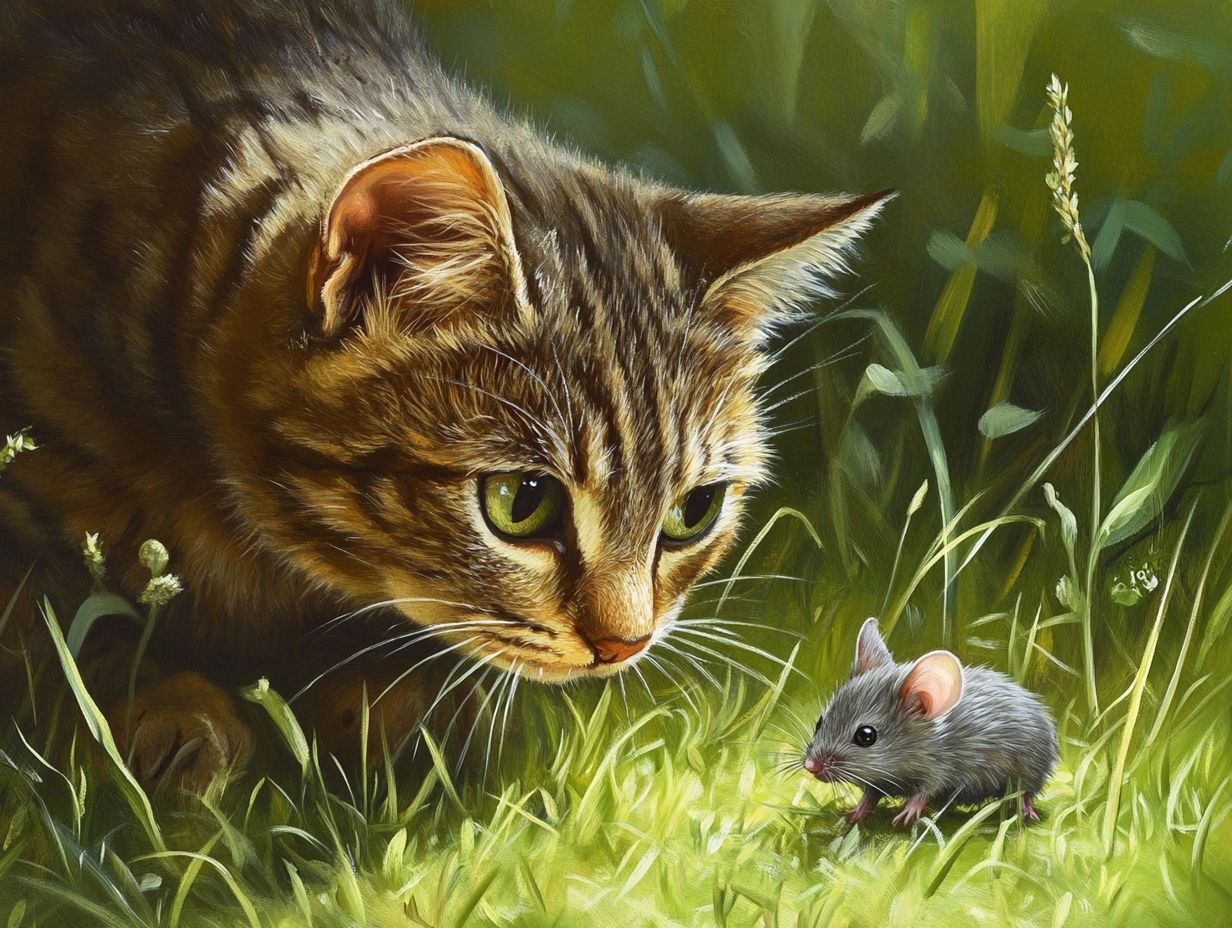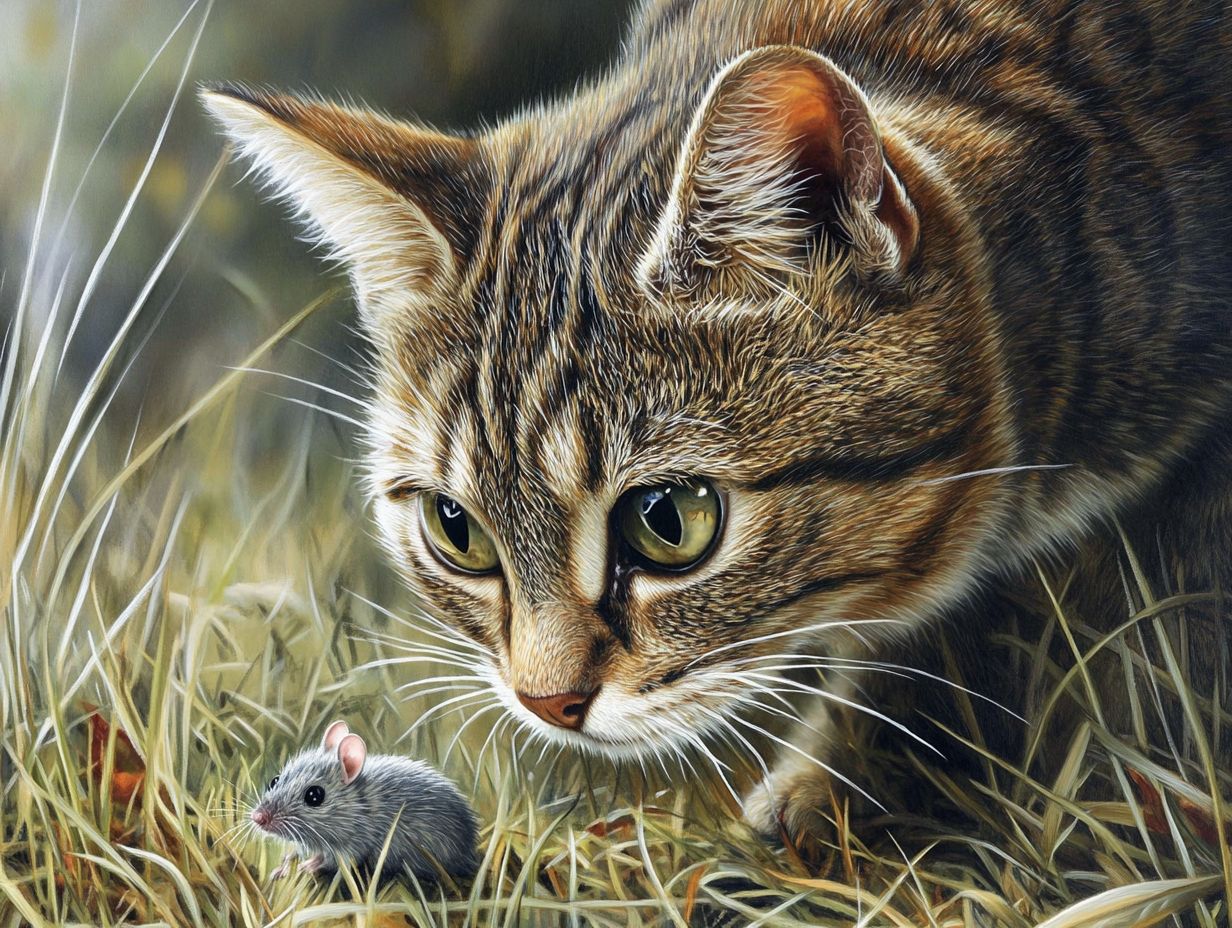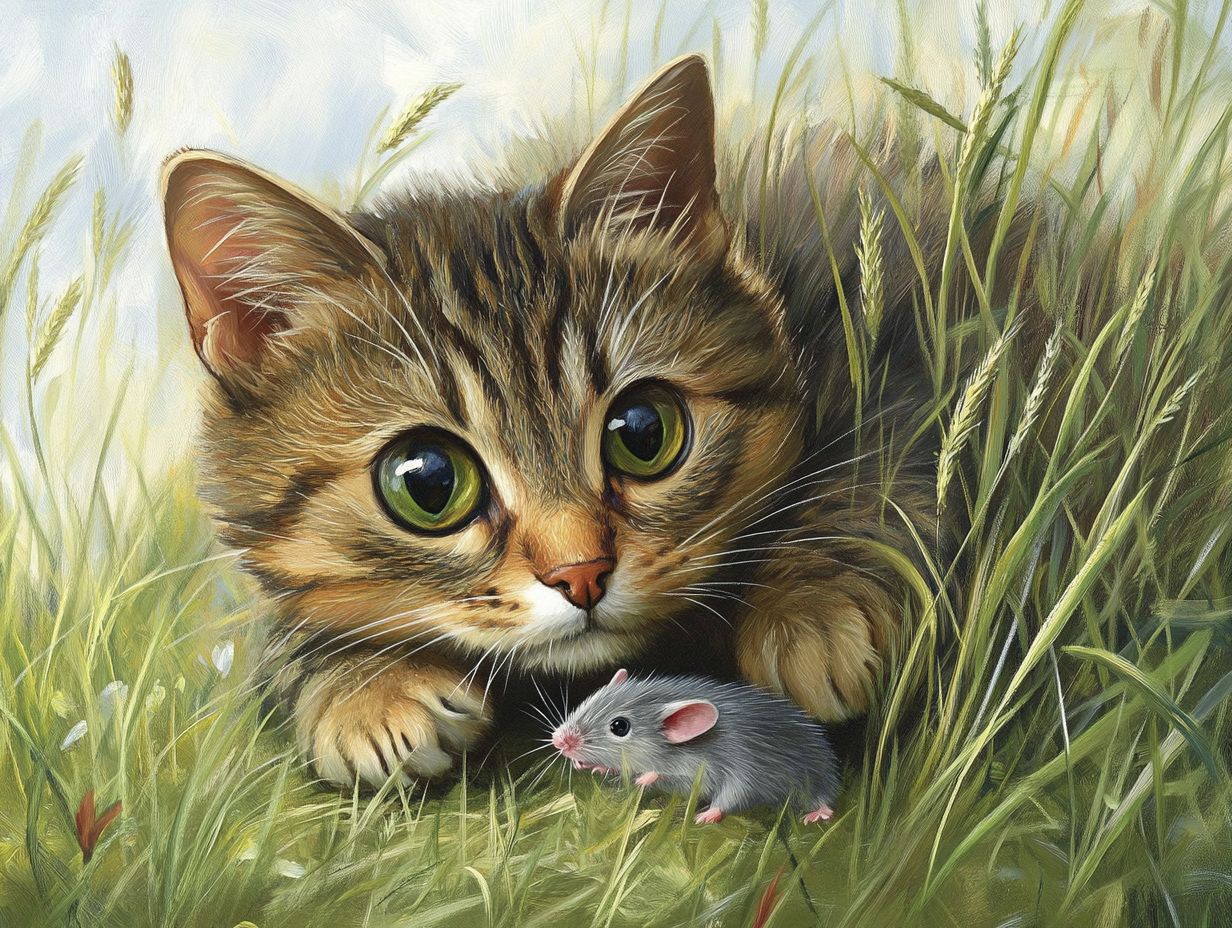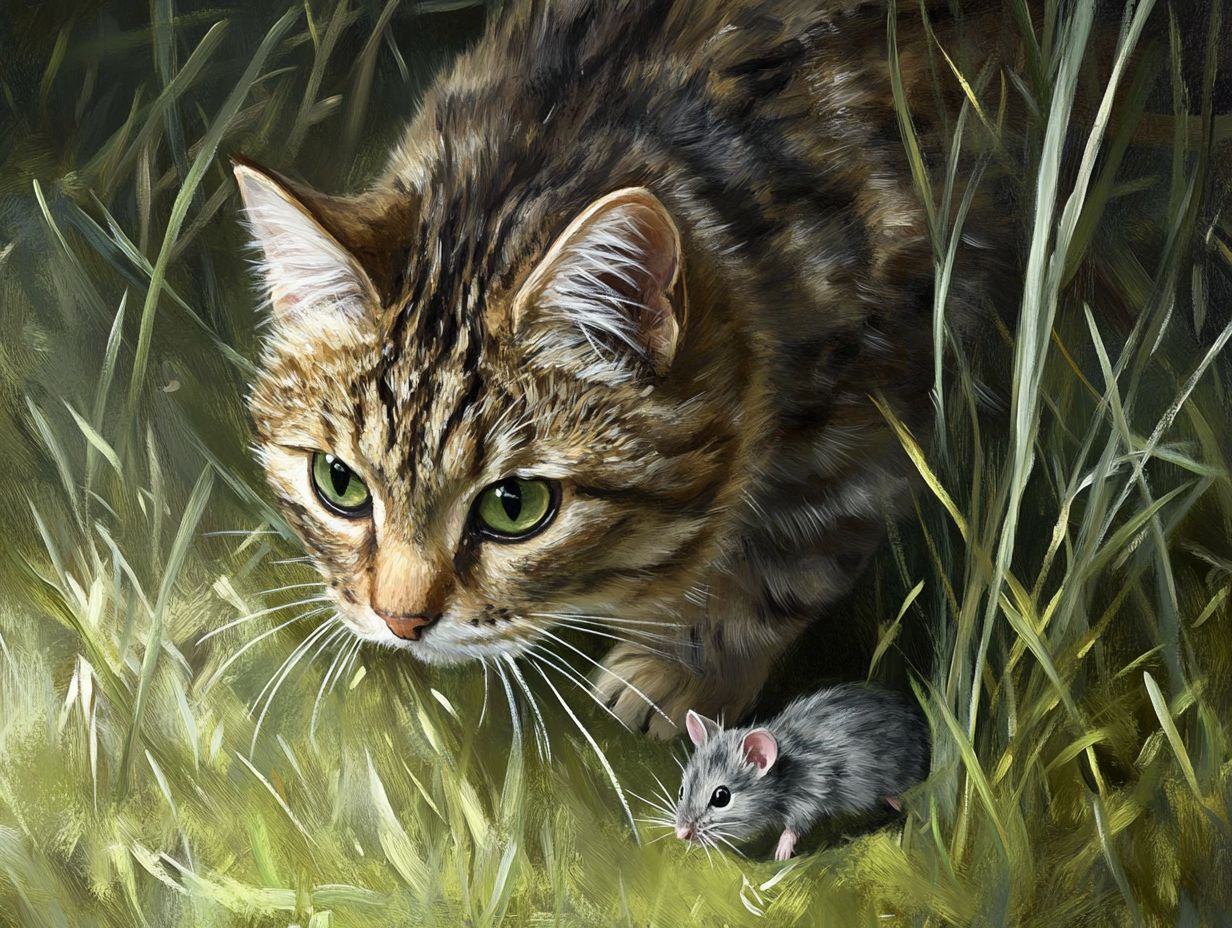Feeding mice to cats can be beneficial, but it also carries risks. This article will explore both sides to help you make an informed decision.
Cats are fascinating creatures, driven by instincts that have shaped their behavior for thousands of years, influenced by their nature as obligate carnivores and skilled predators. Obligate carnivores are animals that require a diet primarily consisting of meat to meet their nutritional needs.
This piece explores the natural hunting instincts of cats, including their tendency to hunt mice, and how these relate to their diet.
Discover what cats truly need to thrive, whether feeding them mice is beneficial or risky, and the potential health impacts of this practice, including issues related to parasites, diseases, and toxins.
Alternative nutrient sources, such as high-quality commercial cat food and high-protein treats, will also be examined to ensure your feline friend is both happy and healthy.
Key Takeaways:

- Cats have a natural hunting instinct, which drives them to hunt and catch prey, such as mice.
- Cats have specific dietary needs, and while mice may provide some nutrients and enrichment, it is important to ensure their overall nutritional needs are met.
- Feeding cats mice can have potential risks and benefits, including exposure to parasites, diseases, and toxins. Owners should carefully consider the health impacts before making this decision.
The Natural Instincts of Cats
Cats are instinctive animals, possessing natural instincts that have evolved over thousands of years from their ancestors, such as the African wildcat. These instincts include hunting, pouncing, and grabbing at prey like mice, which are essential for their survival in the wild.
Such instincts also influence their behavior and interactions, whether in domestic settings or feral environments. Understanding these instincts is crucial for pet owners, as it can help them create safe and stimulating environments at home. This, in turn, supports healthy lifestyles and playful activities that mimic their natural hunting behaviors.
Understanding the Hunting Instinct, Prey, and Predatory Behavior
The hunting instinct in cats is a remarkable behavior rooted in their evolutionary background as predators, enabling them to survive by capturing prey such as mice and birds. This instinct consists of several key components, including stalking, pouncing, and ultimately capturing their quarry.
Stalking allows cats to approach prey stealthily, utilizing their keen senses and agility. The act of pouncing showcases their explosive power, illustrating a finely-tuned balance between speed and precision. Capturing prey not only fulfills a fundamental need for nourishment but also stimulates their physical and mental health.
Engaging in these behaviors keeps cats active, sharpens their reflexes, and provides essential mental stimulation, all of which contribute to their overall well-being. Understanding these instinctual behaviors is crucial for cat owners, as it helps in designing enriching environments and offering appropriate care and feeding, ensuring that these natural drives are both acknowledged and fulfilled.
The Diet of Cats
The diet of cats is one of the most crucial aspects of their care. To maintain their health, cats require specific nutrients in their diets. Taurine, an essential amino acid, plays a vital role in supporting both digestive and cardiovascular health. According to the American Veterinary Medical Association, taurine is not synthesized in sufficient quantities by cats, making its dietary inclusion critical.
As obligate carnivores, cats need a diet rich in animal protein. Most of the nutrients they need are obtained from commercial cat food, which is designed to replicate the natural diets of wild felids, primarily consisting of rodents and birds. The dietary needs of cats are an important area of study within veterinary medicine.
Understanding these needs helps owners feed their cats properly. By knowing the nutritional requirements for energy and specific nutrients like taurine, owners can make informed decisions about the best feeding practices for their cats.
What Cats Need in Their Diet

Cats require a healthy diet that provides essential proteins, vitamins, and minerals, with taurine being particularly crucial for their overall health and well-being. This vital amino acid supports key functions such as heart health and vision, and it is essential because felines cannot synthesize it on their own.
Potential Risks of Feeding Mice to Cats
- Exposure to parasites, such as toxoplasmosis and roundworms.
- Risk of diseases that can be transmitted from rodents.
- Possible exposure to toxins present in wild prey.
If you choose to incorporate mice into your cat’s diet, limit it to no more than 10% of their total food intake to prevent nutritional imbalances.
Conclusion
Incorporating natural prey into your cat’s diet can be enriching, but always consider health risks and ensure a balanced diet. By understanding instincts and dietary needs, you can make informed choices for your feline friend’s well-being.
Feeding cats mice is a topic of interest among pet owners, raising questions about nutrition and health. Can cats eat mice? While the act of feeding mice taps into a cat’s natural instincts, it also carries various health risks that should be carefully considered. This article delves into the nutritional aspects, health impacts, and alternative feeding practices to ensure a balanced diet for your feline friend.
Along with taurine, a well-balanced diet should include adequate amounts of amino acids, fatty acids, vitamins A and E, and certain minerals such as calcium and phosphorus. Pet owners should learn how to properly read food labels to identify high-quality protein sources and minimize filler content, enabling them to make informed choices. It’s essential to verify these nutritional claims with reputable veterinary sources to ensure factual accuracy.
Failing to adhere to these nutritional guidelines can lead to serious health issues, including obesity, heart disease, and other conditions, underscoring the importance of nutrition for a cat’s lifespan and quality of life. Regular veterinary check-ups—ideally every six months—can help monitor and address these issues. Pet owners should watch for specific indicators of health, such as weight changes, lethargy, or changes in appetite.
Can Cats Eat Mice? Insights from Veterinary Experts
Feeding cats mice is a controversial topic, as it nurtures their natural instincts while also posing health risks that need to be managed, including the risk of exposure to parasites and toxins.
Pros and Cons of Feeding Cats Mice and Other Prey
Feeding cats mice has its advantages and disadvantages. On the positive side, it allows cats to engage in their natural hunting behaviors and provides a source of nutrition that closely resembles what they would obtain in the wild. A raw diet can create a more stimulating environment that taps into a cat’s innate instincts, promoting both physical and mental exercise. However, there are significant drawbacks, such as exposure to parasites, toxins, and other health risks.
While encouraging this natural hunting behavior, it is crucial to consider the potential health risks associated with feeding wild prey. These include the transmission of various diseases, such as toxoplasmosis—which can cause symptoms like fever, lethargy, and gastrointestinal issues—and salmonella, associated with symptoms such as vomiting and diarrhea. Additionally, there is the risk of introducing fleas or worms from captured mice, which can jeopardize a cat’s health.
For these reasons, many cat owners opt for high-quality commercial diets that offer similar nutritional profiles to prey. This approach ensures their pets remain healthy while still providing stimulating activities through interactive toys and puzzles that encourage hunting-like behaviors. If you choose to introduce mice into your cat’s diet, consider consulting a veterinarian for safe portion sizes and guidelines for transitioning to a raw diet.
Health Impacts of Mice Consumption and Prevention
The consumption of mice has both positive and negative effects on cats’ health. On the positive side, mice provide essential nutrients, while on the negative side, they can expose cats to parasites and diseases. Both aspects must be considered in relation to a cat’s overall diet.
Specifically, hunting and eating mice can yield various health outcomes for cats, depending on the condition of the mice and the cat’s existing diet. Pet owners should monitor their cats for any signs of illness or discomfort and seek veterinary care if they notice symptoms like vomiting, diarrhea, or unusual behavior after their cats consume wild prey.
Potential Risks and Benefits

Cats eating mice presents both risks and benefits, with the health effects varying significantly based on the circumstances and the individual cat’s health.
The benefits of cats eating mice include the following:
- Mice serve as a natural source of nutrition, providing essential protein and nutrients necessary for a cat’s health.
- Additionally, hunting offers mental stimulation and exercise, which can help reduce the likelihood of obesity.
However, there are also risks associated with cats eating mice:
- Mice can carry parasites or diseases that may be transmitted to cats.
- Furthermore, they might have been exposed to environmental toxins, such as rodenticides, that could harm cats.
To mitigate these risks and benefits, it is advisable to encourage safe hunting practices or to provide controlled environments where cats can engage in their natural behaviors while minimizing health risks. Regular veterinary visits can also help monitor and address any potential issues arising from this behavior.
Alternatives to Feeding Cats Mice for a Healthy Lifestyle
Cat owners who prefer not to feed their pets mice have various alternatives to ensure their cats receive the necessary nutrients and maintain a balanced diet, including high-quality commercial cat food.
Other Sources of Nutrients and Enrichment
In conclusion, while mice can play a role in a cat’s diet, it is vital to consider both the benefits and risks. A balanced diet, combined with regular veterinary consultations, can help ensure your cat leads a healthy and enriched life.
Along with traditional cat food, various nutrient sources and enrichment activities can effectively support a cat’s health and well-being. Pet owners can consider high-protein treats made from real meat or fish, which not only serve as a delicious reward but also provide valuable protein sources that aid in muscle maintenance and energy support. It is recommended that treats make up no more than 10% of a cat’s daily caloric intake.
Specialized supplements designed to enhance fur health or boost immunity can play a crucial role in maintaining overall vitality. Beyond dietary options, interactive toys can promote both mental and physical stimulation. Examples of effective enrichment activities include puzzle feeders, safe outdoor exploration, and training sessions that mimic natural hunting behaviors.
Engaging in various enrichment activities ensures that a cat’s lifestyle is balanced and meets their nutritional and behavioral needs. Using interactive toys, as seen in shows like Tom and Jerry and Disney’s Cinderella, can promote playful activities that further engage their instincts.
Frequently Asked Questions
Can Cats Eat Mice?

Yes, cats can eat mice. In fact, it is a natural and instinctual behavior for cats to hunt and eat small prey such as mice, lizards, and birds. However, it is important to monitor them for any symptoms of illness or discomfort.
Why do cats eat mice?
Cats are natural predators, and their instincts drive them to hunt and eat small prey like mice. This behavior is rooted in their ancestry as wild cats, such as the African wildcat, had to rely on hunting to survive.
Risks of Eating Mice
In most cases, it is safe for domesticated cats to eat mice, considering their natural instincts as hunters. However, significant risks include potential parasites like fleas and ticks, as well as diseases such as toxoplasmosis and hantavirus. It is important to consult with a veterinarian, such as Dr. Amanda Stevens, if your cat regularly eats mice. Monitoring their health and behavior is crucial.
Should I let my cat eat mice or other small prey?
While it is a natural behavior for cats, it is generally not recommended to let your feline eat mice due to the potential risks, including allergies and digestive issues. Instead, provide your cat with a balanced and nutritionally complete diet, rich in taurine, to ensure their health and well-being. Commercial cat food is often tailored to meet these needs, and safe alternatives can satisfy their hunting instincts without the associated risks.
Can eating mice cause behavioral changes in cats?
Yes, eating mice can sometimes lead to notable behavioral changes in cats. Some may display more aggressive or territorial behavior due to their instinct to hunt. This is often seen in both domesticated and feral cats who regularly engage with wild prey such as rodents.
How can I prevent my cat from eating mice and other prey?
To prevent your cat from eating mice, it is important to provide sufficient mental and physical stimulation through play and toys that mimic the thrill of the hunt. Regularly rotating toys and incorporating training sessions can keep their environment stimulating and reduce the urge to hunt. Additionally, keeping your cat indoors or in a safe enclosed outdoor environment can limit their access to wild rodents and other potential prey such as birds or lizards. Regular veterinary check-ups and care are crucial for their safety and health.
Safe Alternatives
Consider offering safe alternatives to satisfy your cat’s hunting instincts, such as feather wands or laser pointers, that allow for interactive play without the risks associated with wild prey.
Key Takeaways: It is essential to maintain balanced nutrition for your cat while being aware of their natural instincts. High-protein treats can be a part of their diet, but keep them within recommended portion sizes. Prioritize safe feeding practices and engaging activities to support your cat’s overall well-being.